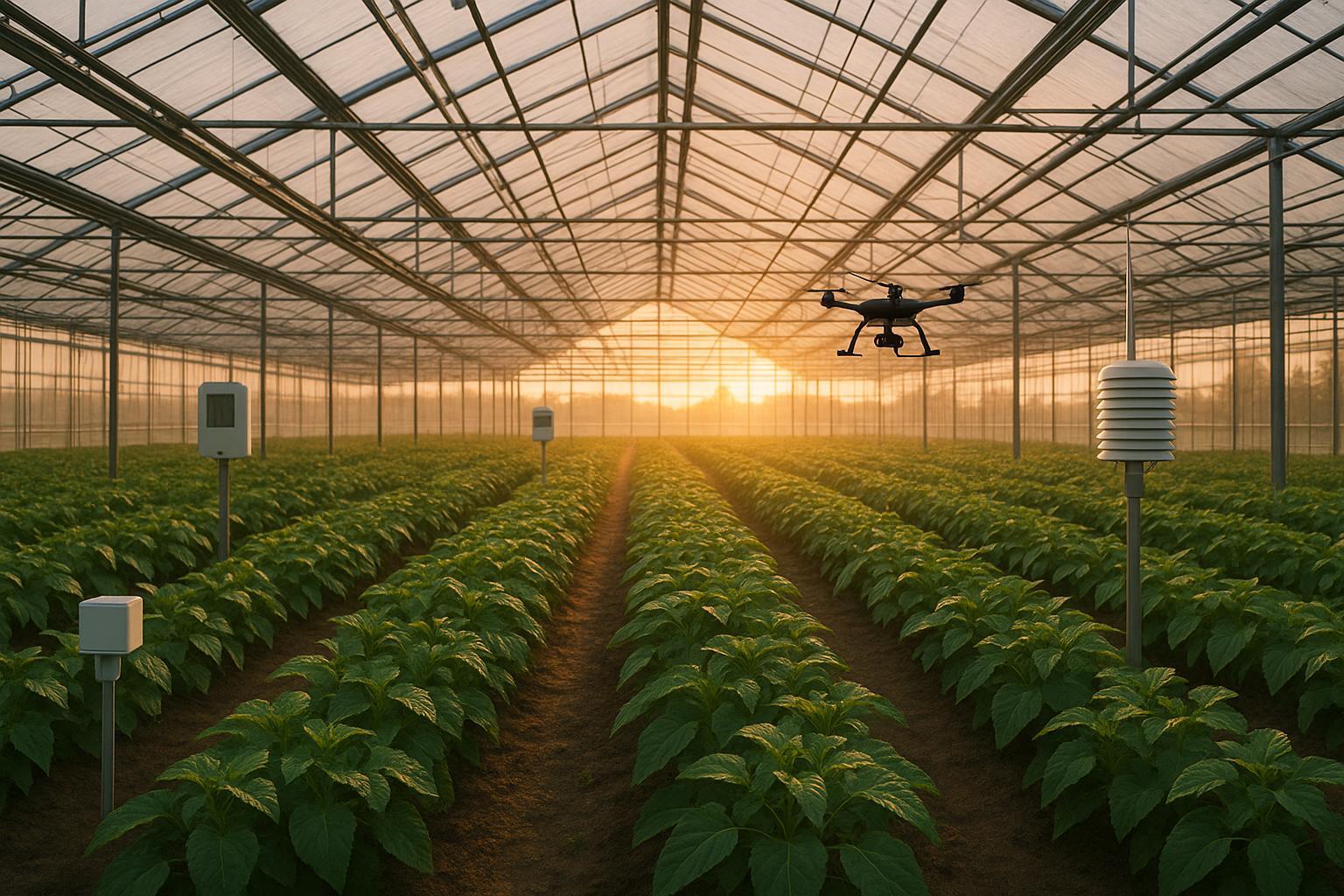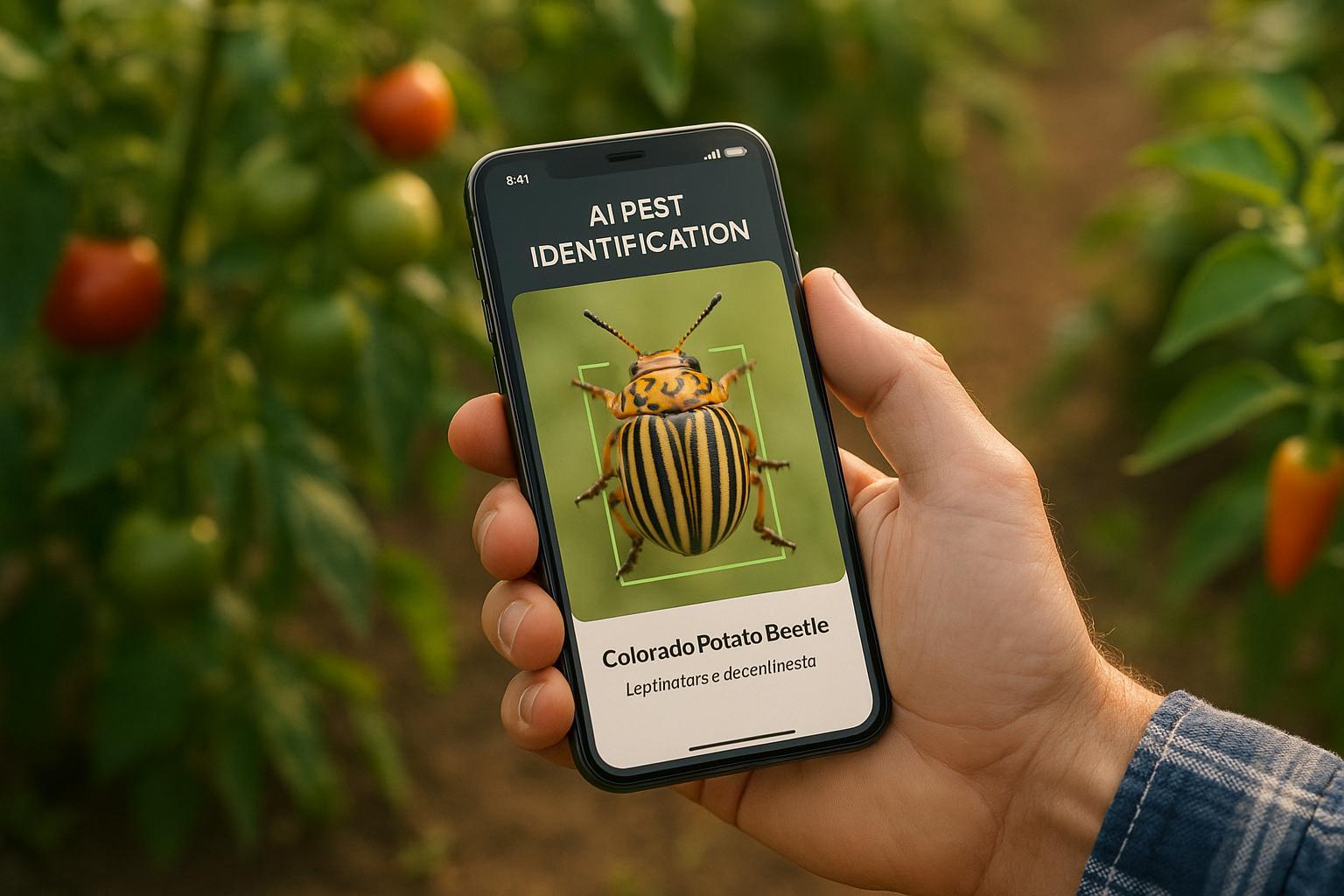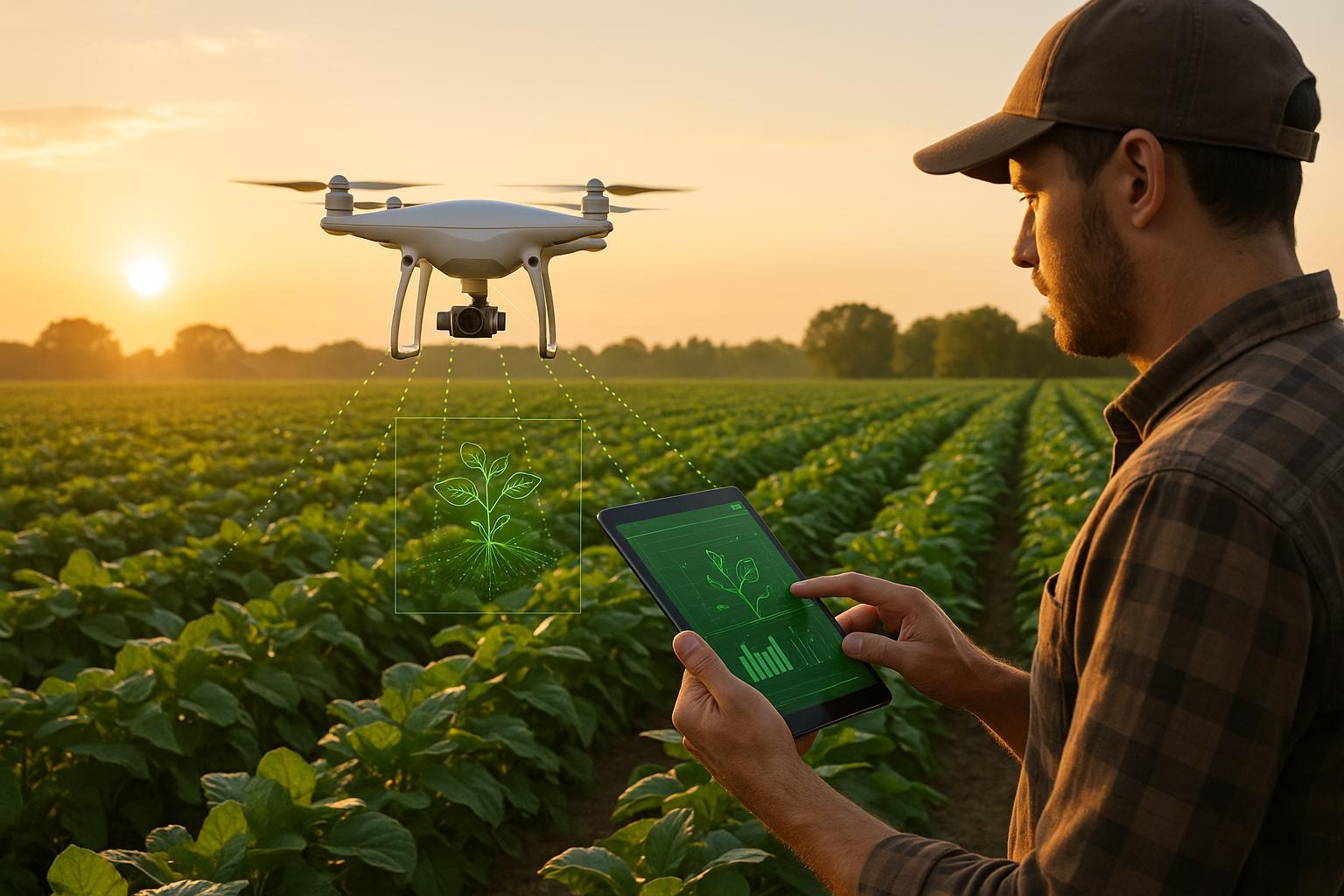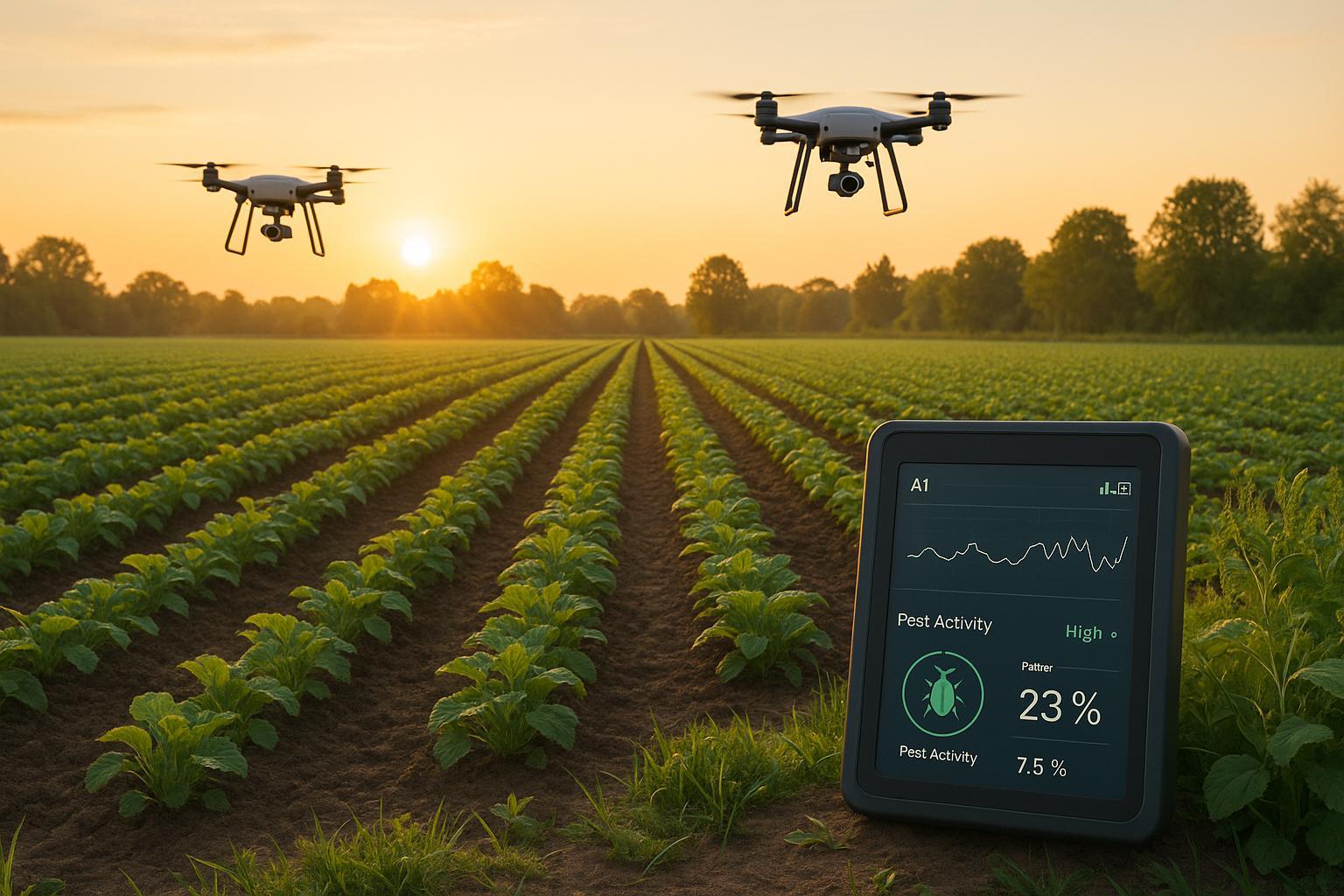Big Data for Climate-Specific Pest Control

Farmers across the U.S. are using big data analytics to manage pests more effectively by tailoring strategies to local climate conditions. This approach moves away from fixed schedules and instead uses real-time data to predict pest behavior and optimize interventions. Key benefits include lower costs, reduced pesticide use, and better crop protection.
Here’s how it works:
- Data sources: Weather stations, soil sensors, satellite imagery, and pest traps provide detailed insights into local conditions.
- Predictive models: These tools analyze climate patterns and pest behavior to forecast outbreaks and suggest optimal treatment times.
- AI tools: Platforms like AIGardenPlanner simplify data for farmers and even home gardeners, offering specific, localized pest control advice.
Precise , Immediate AI Pest Management

Key Data Sources and Their Role in Pest Control
Managing pests in a climate-specific way relies on combining a variety of data sources into one cohesive, actionable framework. Each source offers unique insights, and when these are properly integrated, they create a precise approach to timing and targeting pest control efforts. Together, these inputs form the foundation for effective analysis and decision-making in pest management.
Primary Data Sources
Weather monitoring networks are essential for climate-based pest control. The National Weather Service operates more than 8,700 automated weather stations across the U.S., delivering real-time updates on temperature, humidity, rainfall, wind speed, and barometric pressure. These frequent measurements provide a detailed look at microclimatic conditions that influence pest life cycles.
Pest monitoring traps - like pheromone, sticky, and light traps - track field pest populations. Modern digital traps take this further by wirelessly transmitting data, enabling continuous and remote monitoring.
Satellite imagery tools, such as MODIS with its 250-meter resolution or Landsat with 30-meter resolution, offer a bird’s-eye view of crop health and environmental factors that contribute to pest pressures.
Soil sensor networks keep tabs on underground conditions that impact both soil-dwelling pests and overall plant health. These sensors measure soil temperature, moisture, pH levels, and nutrient concentrations at various depths, providing clues about when pests might emerge above ground.
Crop health monitoring systems detect early signs of plant stress, often caused by pests, before visible damage appears. Using spectral analysis cameras mounted on drones or ground-based sensors, these systems pick up changes in leaf reflectance, signaling issues like pest feeding, diseases, or nutrient deficiencies. This allows for quick action before the situation worsens.
Historical pest outbreak records serve as a critical baseline for predicting future patterns. Databases maintained by agricultural extension services, research institutions, and farming cooperatives document past outbreaks, including timing, severity, weather conditions, and control measures. These records help identify recurring trends and seasonal risks.
Data Integration Methods
After collecting data from these sources, the next step is to bring everything together using advanced integration tools.
Real-time data fusion platforms aggregate data streams - like weather stats, pest trap counts, satellite images, and sensor readings - into unified dashboards. These interactive maps and charts let farmers compare current conditions with historical trends, making it easier to make informed decisions.
Machine learning algorithms analyze patterns across multiple data types, uncovering correlations that might otherwise go unnoticed. For instance, they could reveal that a specific mix of temperature and humidity often leads to aphid outbreaks.
Geographic Information Systems (GIS) layer various data types to show spatial relationships between climate conditions and pest activity. By visualizing weather patterns, soil characteristics, crop locations, and pest trap data on a single platform, managers can pinpoint high-risk areas and allocate resources more effectively.
Predictive modeling engines use integrated data to forecast future pest activity. These tools incorporate weather predictions, historical outbreak data, current pest populations, and crop growth stages, updating continuously as new information comes in.
Mobile apps and API integrations ensure that field observations are seamlessly linked to centralized databases. Farmers and field scouts can upload real-time observations via mobile apps, while APIs connect different software systems for smooth data sharing between weather services, farm equipment, and management platforms.
These integration methods transform raw data into clear, actionable insights. AI-driven tools like AIGardenPlanner (https://aigardenplanner.com) simplify complex data, offering user-friendly recommendations that help farmers and gardeners implement timely pest control measures with confidence.
Big Data Analytics for Pest and Climate Patterns
Big data analytics turns raw information into actionable insights, especially when it comes to understanding the relationship between climate patterns and pest activity. By using correlation analysis, these platforms examine how multiple climate factors - like cumulative heat and rainfall - interact with pest behavior. For instance, they can reveal connections between pest emergence and heat accumulation while factoring in recent rainfall data. This multi-variable approach offers a much sharper lens for predictions compared to traditional, single-factor methods.
Time-series analysis takes this a step further by tracking pest population data over extended periods. This method identifies seasonal trends and long-term shifts, shedding light on how pests might be adapting to changing climate conditions. Such insights allow growers to tweak their pest control strategies effectively. On top of this, spatial analytics focus on localized risks, adding another layer of precision.
Using geographic data, spatial analytics generate detailed pest risk maps. By layering data like soil moisture, temperature variations, and historical pest activity, these tools highlight areas most vulnerable to infestations. This enables growers to target specific zones instead of applying broad measures, laying the groundwork for predictive models that make pest management more efficient.
Predictive Models for Pest Management
The patterns uncovered by big data analytics feed directly into predictive models, which help optimize pest control strategies. Models such as degree-day and phenology systems combine factors like cumulative heat, humidity, and daylight hours to predict key pest development stages. For example, these models track heat accumulation above a specific base temperature to forecast when pests, like the Colorado potato beetle, will reach critical life stages. By using local temperature data, they calculate daily heat units and alert growers when thresholds are met.
Population dynamics models take it further by simulating how pest populations grow under various climate conditions. These models consider factors like reproduction rates, mortality, and weather-driven migrations, offering insights into both the timing and scale of pest outbreaks.
Machine learning adds another layer of sophistication. By processing vast amounts of historical pest and climate data, algorithms like neural networks can identify complex, non-linear patterns. These systems detect sequences of weather events that signal ideal conditions for pest outbreaks, offering growers a heads-up before issues escalate.
Ensemble modeling combines multiple prediction techniques to improve accuracy. By running several models simultaneously and weighing their results, this method minimizes errors and provides more reliable forecasts.
Benefits Over Traditional Methods
Predictive models deliver clear advantages over older, more reactive pest management techniques. Here's how they compare:
| Aspect | Traditional Pest Control | Big Data Analytics Approach |
|---|---|---|
| Timing Accuracy | Based on fixed schedules | Adjusts interventions using real-time climate data |
| Cost Efficiency | Broad-spectrum treatments applied routinely | Targets specific areas, reducing overall costs |
| Environmental Impact | Affects non-target species | Focused treatments protect beneficial organisms |
| Labor Requirements | Relies on manual scouting | Automated systems save time and effort |
| Treatment Coverage | Uniform application across fields | Focuses on high-risk zones identified by data |
| Response Time | Delayed reaction to infestations | Provides timely alerts for quicker action |
| Resistance Management | Limited adaptability in strategies | Data-driven adjustments manage resistance effectively |
The shift from traditional, calendar-based methods to predictive pest management is reshaping how growers approach pest control. Older methods often relied on visual inspections and fixed schedules, which could miss optimal intervention windows. In contrast, big data analytics allows for proactive decision-making by predicting pest activity before it becomes a visible problem.
With analytics, precision is the name of the game. Instead of treating entire fields uniformly, growers can focus their resources on high-risk areas identified through localized data on climate and pest density. This not only reduces pesticide use but also maintains effective control.
Moreover, the feedback loop created by big data helps track how well different control strategies perform under changing conditions. This continuous monitoring supports adjustments to treatment plans, ensuring long-term success in managing pests while minimizing environmental impact.
sbb-itb-4d6a8dd
🚀 Ready to Reinvent Your Garden?
Join thousands of homeowners who have transformed their gardens using our AI design tool. Upload one photo to explore endless possibilities.
Get your AI garden designs →Practical Applications and Case Studies
Big data is reshaping pest control strategies across the United States, offering farmers precise, data-driven tools to protect their crops. From large-scale agricultural operations to smaller community efforts, these approaches are transforming how pests are managed.
Agricultural Case Studies
Take corn growers in the Midwest, for example. They’ve adopted integrated data systems to tackle the European corn borer, a pest that wreaks havoc on crops every year. These systems pull information from weather stations, soil sensors, and satellite imagery to track temperature patterns and predict when adult moths will emerge. Using degree-day models, farmers receive alerts about the pest's most vulnerable stages, enabling them to act during peak egg-laying periods.
In Texas, cotton farmers are using similar strategies to manage bollworms. By combining climate data with pheromone trap counts, they’ve been able to cut down on insecticide use while keeping pest populations under control. These systems monitor daily temperature swings and humidity levels, allowing farmers to fine-tune their approach to bollworm management.
Precision agriculture platforms take it a step further by integrating multiple data sources - weather stations, soil moisture sensors, and drone imagery - to provide field-specific recommendations. This means treatments can be targeted to areas within a field that show higher pest activity, saving resources and improving outcomes.
Apple orchards in Washington have also embraced data-driven pest control. Growers use systems that monitor codling moth development, pinpointing the biofix dates that signal the start of moth activity in spring. These dates, combined with heat unit calculations, help predict when new generations of moths will appear.
Meanwhile, vineyard managers in California’s Central Valley are tackling grape phylloxera by combining soil temperature data with historical infestation records. This approach helps identify high-risk vineyard blocks during specific weather conditions, allowing for proactive management.
These examples highlight how precise, data-informed strategies are driving success on individual farms.
Community-Based Data Sharing
While individual farms benefit from tailored data, regional collaboration takes pest management to the next level. The National Agricultural Pest Information System (NAPIS) is a prime example of this. It facilitates data sharing among farmers, extension agents, and researchers across state lines. By pooling local observations on pest activity, weather patterns, and treatment results, participants build robust regional databases that sharpen pest control strategies.
In Nebraska, for instance, corn and soybean farmers use digital platforms to share information about soybean aphid populations and local weather trends. This kind of collaboration helps identify regional pest patterns that might go unnoticed by individual farms.
Beyond traditional agriculture, cooperative weather monitoring networks now include community-supported agriculture groups, urban farms, and even suburban gardeners. These contributors help create detailed climate maps that track pest movements between agricultural and residential areas.
Regional commodity groups have also developed protocols to protect farm privacy while contributing to collective knowledge. In the Southeast, cotton growers share anonymized data on pest pressure and treatment timing, enabling researchers to spot trends across different soil types and microclimates.
University extension programs play a key role in these efforts, often coordinating multi-state research projects to study pest movement and climate interactions. They provide farmers with regional forecasting models in exchange for local data contributions, ensuring a mutually beneficial arrangement.
One standout initiative is the Integrated Pest Management Pest Information Platform for Extension and Education (IPM PIPE). This platform aggregates pest monitoring data from across the country, giving users access to regional forecasts and allowing them to compare local conditions with broader trends.
Mobile apps have made it easier for smaller operations to join these efforts. Farmers can quickly report pest sightings, upload photos for identification, and share treatment results directly from their smartphones. This real-time data collection improves predictive models and helps flag emerging pest issues before they spread.
These collaborative approaches show how community-driven data sharing amplifies the power of big data analytics, helping agricultural communities build robust datasets and improve pest management on a larger scale.
Even home gardeners are benefiting from these advancements. Platforms like AIGardenPlanner now provide climate-specific pest and plant health recommendations, bringing the power of big data to backyard gardens.
Challenges, Opportunities, and AI Tools
Big data has opened up new possibilities for pest control, but integrating it into practical use comes with its own set of hurdles. Meanwhile, AI-powered platforms are stepping in to make advanced pest management strategies accessible to everyone - from large-scale farmers to home gardeners. These challenges highlight the need for AI solutions that simplify decision-making and improve pest control methods.
Tackling Data Challenges
To fully harness the potential of big data, several obstacles need to be addressed. Concerns about data privacy, limited broadband access in rural areas, and a lack of technical training can hinder adoption. Additionally, reliable data collection is essential - errors from sensors can result in false alarms or missed warnings, undermining the effectiveness of pest management systems.
The Role of AI-Powered Platforms
AI-powered platforms are stepping up to address these challenges by organizing and interpreting complex data into actionable insights. Take AIGardenPlanner as an example. This tool uses local climate data and user inputs through its AI Plant Advisor feature to deliver personalized guidance on plant health and pest prevention.
With automation at its core, users no longer need to decipher intricate weather patterns or pest lifecycles manually. By simply entering their location and garden specifics, they receive tailored advice on how to protect their plants and choose the best crops for their environment.
AIGardenPlanner bridges the gap between advanced climate analysis and everyday gardening. It offers tools that are practical for professionals yet affordable for home gardeners and small landscaping businesses. The platform integrates diverse data sources to streamline decision-making, making insights once reserved for large agricultural enterprises available to everyone.
For home gardeners, this means detailed guides that address local climate challenges, including pest management, as part of a broader garden care strategy. Professionals, on the other hand, gain access to high-resolution design tools that combine aesthetic appeal with functionality, enabling them to create pest-resistant landscapes with long-term viability.
The Future of Climate-Specific Pest Control
The integration of big data is transforming garden management from a reactive process to a predictive one, enabling proactive pest control that’s informed by real-time climate data.
Machine learning is playing a key role here. These algorithms are getting better at spotting connections between factors like temperature changes, humidity levels, and pest activity cycles. With this knowledge, systems can now accurately forecast when specific pests are likely to appear in certain areas. This allows for precise interventions, reducing both environmental impact and costs.
One of the most exciting shifts is how accessible these advanced technologies have become. Tools that once required costly consultations and complex data analysis are now available through easy-to-use platforms. Take AIGardenPlanner, for example. This platform merges climate data analysis with practical garden design, offering home gardeners and small landscaping businesses a way to manage pests effectively. Its AI Plant Advisor simplifies complex climate and pest data into straightforward recommendations, covering everything from plant selection to natural pest deterrence. This evolution is paving the way for even more progress in integrated pest management.
Looking ahead, the combination of IoT sensors, satellite imagery, and artificial intelligence promises even greater precision. Real-time monitoring of soil conditions, plant health, and local weather will allow for instant adjustments to pest control strategies. This means moving past fixed schedules to a more responsive, dynamic approach.
By focusing on targeted pesticide use and identifying pests early, these systems can help prevent crop losses while cutting down on chemicals. For professional landscapers, this technology offers a clear edge - giving them the ability to create data-driven maintenance plans that keep gardens thriving and reduce long-term costs for their clients.
As climate change reshapes pest behavior and introduces new challenges, data-driven pest management will become essential for adapting to these shifts. These advancements signal a move toward a more sustainable, data-focused approach for gardens of all sizes.
FAQs
How does big data make pest control more accurate and efficient compared to traditional methods?
Big data is transforming pest control by leveraging advanced analytics to predict outbreaks and monitor conditions in real time. This approach enables precise, timely interventions, cutting down the reliance on broad, reactive measures.
Traditional pest control often leans heavily on chemical treatments, but big data takes a different route. It empowers data-driven decisions, optimizing pesticide usage, conserving resources, and limiting environmental harm. By aligning strategies with specific climate patterns, this method promotes more efficient and sustainable pest management practices.
What data is used to develop climate-specific pest control strategies, and how does it help predict pest activity?
Climate-focused pest control strategies draw on a wide range of data, such as detailed climate reports, atmospheric conditions, remote sensing technology, and pest monitoring systems. By studying variables like temperature, humidity, and seasonal shifts, these methods can more accurately predict pest activity and potential outbreaks.
This approach enables precise pest control measures, cutting down on the use of broad-spectrum treatments and lessening their impact on the environment. It ensures that actions are well-timed and specifically designed to align with the unique climate conditions and pest behaviors of a given area.
How can AI tools like AIGardenPlanner help home gardeners manage pests based on their local climate?
AI tools like AIGardenPlanner are transforming pest management for home gardeners by analyzing local climate factors such as temperature, humidity, and seasonal patterns. This analysis helps predict pest activity and suggests eco-friendly, targeted strategies to prevent infestations, minimizing the need for chemical interventions.
On top of that, advanced features like image recognition can identify specific pests, allowing gardeners to take precise, region-specific actions. By blending climate-based insights with accurate pest identification, these tools make pest control more efficient and environmentally friendly, ensuring your garden stays healthy and productive year-round.
🎨 Visualize Your Dream Garden Today!
Transform any outdoor space into a professional landscape design in minutes. Just upload a photo, choose your style, and let our AI do the rest.
Start your garden transformation now →Related posts
Related Articles

IoT in Biocontrol: Case Studies
Explore how IoT technology is revolutionizing pest management through precision, efficiency, and sustainable practices in agriculture and gardening.

Ultimate Guide to AI Pest Identification Tools
Explore how AI pest identification tools revolutionize pest management for gardeners and farmers, offering efficiency, accuracy, and sustainability.

How AI Sensors Sync Data for Pest Control
Explore how AI sensors are revolutionizing pest control with real-time data syncing and precise detection for effective crop protection.

The Benefits of Shopping at a One-Stop Garden Shop
Discover the convenience and expertise of shopping at a one-stop garden shop for all your gardening needs. Improve your well-being and reduce your carbon footprint with our extensive selection of high-quality products and expert advice.

AI in Integrated Pest Management Systems
AI is revolutionizing pest management by enhancing detection, resource efficiency, and sustainability in agriculture, while addressing challenges of traditional methods.

AI in Risk-Based Pest Control Systems
Explore how AI is revolutionizing pest control with predictive technologies that enhance efficiency and reduce pesticide use for farmers and gardeners.